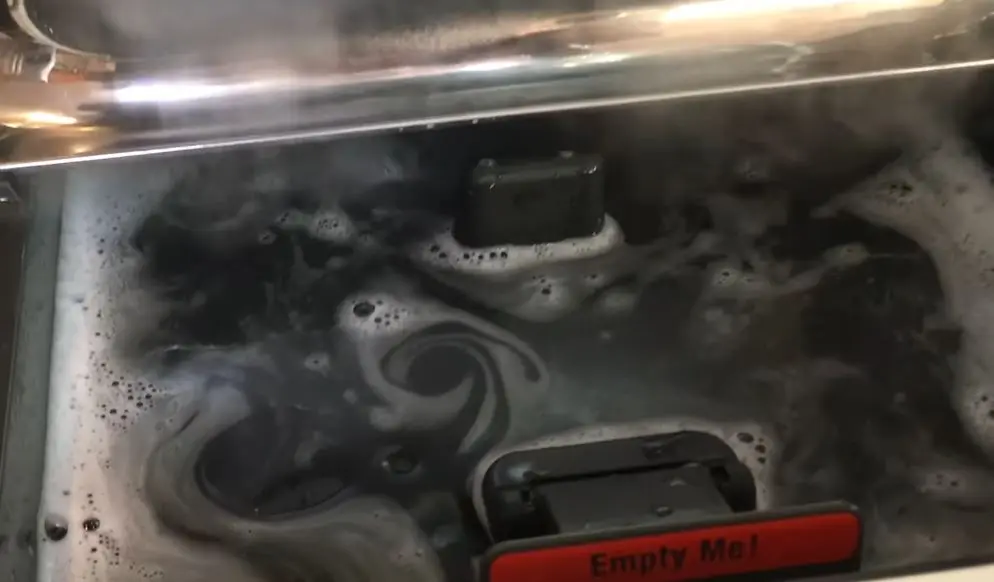Breville Barista Pro is equipped with a “flush cycle”, a built-in backflushing feature to keep the espresso machine in good working condition for longer. But it can stop working suddenly without any prior warning.
Breville Barista Pro flush can malfunction for many reasons. The flush cannot work because of a clogged group head, a damaged valve, a selection of wrong flushing discs, and so on.
In this post, we will discuss some familiar reasons behind Breville Barista Pro flush not working and its potential solution. Keep reading to learn more.
Breville Cleaning Cycle Not Working: Possible Causes

Many issues can prevent your Breville Barista Pro from flushing. However, the following are prevalent reasons behind the trouble.
1. The Group Head of Your Breville Barista Pro Is Blocked
Group head clogging is one of the most common reasons that cause no flushing in Barista Pro and other espresso machines. The group head can get blocked with grind waste, coffee oil, and other debris.
If your Barista Pro espresso machine’s group head becomes clogged anyhow, the water cannot pass through it as expected. It is a common reason which interrupts in backflushing process of espresso machines.
The group head doesn’t get jammed overnight but slowly. When the clog starts forming, you can also experience terrible espresso quality.
2. Your Barista Pro Has A Malfunctioning Valve
An espresso machine’s valve looks very small, but the device is responsible for functioning the espresso machine and performing espresso brewing. A valve ensures accurate water flow and generates adequate water pressure.
If the valve of your Barista Pro becomes damaged, it can prevent the machine from backflushing. A malfunctioning valve will also fail to flow water into the group head. It even cannot generate sufficient pressure required for back flushing.
Read: Breville Espresso Machine Not Pumping Water – Anyone Can Fix!
3. The Back Flush Disc Has an Issue
The backflushing issue also can occur because of the disc’s fault. Choosing the wrong size flushing disk or having no hole in its center are two common reasons for the problem.
Breville Barista Pro works with a 54mm portafilter. So, you must choose a backflushing disc with a similar diameter. A disc bigger or smaller than this diameter will cause trouble during flushing.
Though older backflushing discs had holes in the center, modern discs are entirely blind. The hole lets water and air pass through and reduce pressure buildup during the backflushing process.
When using a blind disc, the flushing process can also be interrupted if your espresso machine cannot handle excessive water pressure.
Read: Guide to Fixing Low Pressure in Breville Espresso Machines
Possible Solutions to Breville Barista Pro Not Flushing
If you have discovered any of the above issues, the following techniques should solve them.
- Clean your espresso machine regularly, including the group head. Routine cleaning will keep the machine’s group head free of clogs so that you can backflush properly.
- If you have found the machine’s valve cannot generate sufficient water pressure for the backflush, repair it immediately. Fixing or replacing a faulty valve will also enhance your espresso quality along with appropriate backflush.
- Make sure that you are using an accurate size flushing disc. Also, ensure that the disc has a small hole in the middle in case of a flushing issue using a blind disc.
FAQs Breville Espresso Machine Flush Not Working
Flushing in the Breville Barista Pro is a built-in cleaning cycle, which is also called backflush. It cleans the inner section of the machine to remove any loose grounds, coffee oils, and other remaining.
Flushing in the Breville Barista Pro is a built-in cleaning cycle, which is also called backflush. It cleans the inner section of the machine to remove any loose grounds, coffee oils, and other remaining.
Backflushing is crucial to keep an espresso machine in good condition and enjoy fresh-tasting espresso for longer.
Final Words
Your Breville Barista Pro flush may not work due to the above reasons. However, it is a common issue and can be fixed at home by a simple technique. If you have located no issue and failed to resolve the flushing problem, contact Breville customer care for professional assistance.
Hi Daniel,
Great article. Was wondering if you ever had the group head suddenly lose pressure during this backflush? I used the cleaning disk in the single shot basket like they show in their YouTube video and when the machine built maximum pressure, it released suddenly and water went everywhere. It was almost like the rubber gasket failed. I replaced the gasket and have just been trying to brew espresso and the gasket it still failing even at a reduced pressure.
Curious to know if you had heard or experienced anything like this in the past?
Thanks.
Hi Tyler,
Sometimes, the group head can lose pressure suddenly during backflushing. However, in your case, the issue appears that there might be a problem with the rubber gasket in your espresso machine’s group head. Since it continues to fail even after replacing the gasket, I recommend reaching out to the manufacturer’s customer support or a professional technician to diagnose and fix the problem.